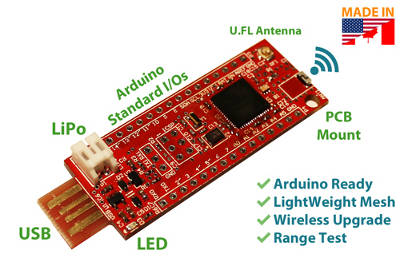| MiniSWARM - Arduino WiFi Mesh |
| Written by Harry Fairhead | |||
| Sunday, 28 April 2013 | |||
|
If the Internet of Things is ever going to take off, we need cheap connected computing devices. The miniSWARM is only $20 and it's a WiFi mesh-connected Arduino - and that's just a start. Building small, wireless connected, sensors or control modules is currently more difficult than it should be because the hardware just isn't right for the job. The Arduino is easy to use, but you need an expensive WiFi, Bluetooth or Zigbee addon board to make it part of a wireless network. Recently we carried news of the RFduino, a low cost Bluetooth module which had more than reached its target on KickStarter. Now we have MiniSWARM, which is a full WiFi enabled Arduino looking for funding on Indiegogo. Why do we need an alternative? The answer is that Bluetooth is great for connecting modules to other Bluetooth enabled devices, such as an Android tablet or phone. However, Bluetooth only has a range of around 10 meters and not all devices support it. On the other hand, WiFi is almost universal and can support connections over tens of meters. Its big problem is that it is complex both from the hardware and the software point of view.
Enter MiniSWARM. This is a small and cheap open source project complete with a Arduino compatible controller and a WiFi radio. At the moment it doesn't support connection to a standard WiFi network because there is no WiFi Ethernet stack available. What it does support is Amtel's Lightweight Mesh stack which allows miniSWARM devices to communicate with each other by passing data over what look like serial ports. This makes the device idea for implementing sensor networks and, of course, swarms of autonomous robots which is presumably why it is called miniSWARM. There is a built-in aerial and it should achieve ranges of 30 meters indoors and 100 meters outdoors. For more range you can connect an external aerial.
It is completely self-contained and doesn't even need a USB cable because the board has a USB connector which allows you to plug it directly into a socket as if it was a pen drive. It has a standard Arduino I/O pin set on the edge of the board and an LiPo battery connector. You can download your Arduino sketches to it and start using the device. One of the really interesting ideas is over-the-air programming. This is currently in beta, but it would allow update of deployed devices without having to recover them and connect to a USB socket. As a basis for a sensor network, this looks like a good place to start. The only difficulty is in getting the device to communicate with a full WiFi network. Currently the solution is to add a WiFi shield to one of the miniSWARMs - or of course you could just plug one into a USB socket. Perhaps I will be able to by a wireless remote temperature sensor for less than $100 in the near future. If you think the project is worth supporting, visit Indiegogo and pledge $20 or more to get miniSWARM hardware once it is ready. More InformationRelated ArticlesForget Raspberry Pi - RFduino Is Coming Arduino Micro - Leonardo's Capabilities in a Tiny Package Learn Electronics with Arduino
To be informed about new articles on I Programmer, install the I Programmer Toolbar, subscribe to the RSS feed, follow us on, Twitter, Facebook, Google+ or Linkedin, or sign up for our weekly newsletter.
Comments
or email your comment to: comments@i-programmer.info
|
|||
| Last Updated ( Sunday, 28 April 2013 ) |



